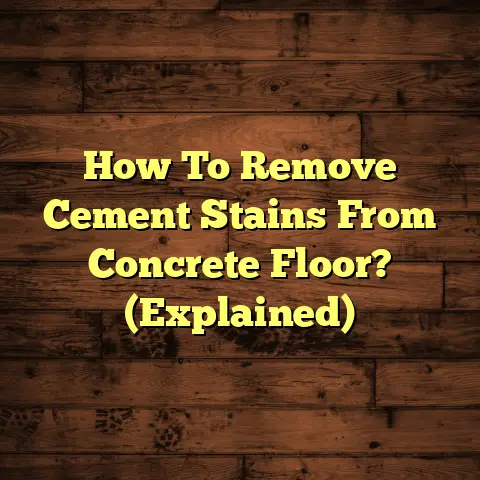Vinyl or Laminate? (1 Test You MUST Know!)
Choosing new flooring can feel like embarking on a long road trip, right?
You wouldn’t just hop in any old car and expect a smooth ride, would you?
You’d consider the terrain, the weather, and who’s coming along for the journey.
Similarly, picking between vinyl and laminate flooring requires careful consideration.
Think about your lifestyle, your budget, and the specific room you’re flooring.
Let’s dive into the world of vinyl and laminate, and I’ll share a crucial test that can save you from costly mistakes.
Section 1: Understanding Vinyl Flooring
So, what is vinyl flooring anyway?
Essentially, it’s a synthetic flooring made primarily from PVC (polyvinyl chloride) and other compounds.
It comes in various forms, like:
- Luxury Vinyl Planks (LVP): Designed to mimic hardwood planks.
- Luxury Vinyl Tiles (LVT): Resemble ceramic or stone tiles.
- Sheet Vinyl: Large rolls that cover an entire room with minimal seams.
One of the biggest draws of vinyl is its water resistance. It’s practically impervious to moisture, making it a fantastic choice for kitchens, bathrooms, and basements.
Plus, it’s known for its durability. High- quality vinyl can withstand heavy foot traffic and resist scratches and dents.
Installation is often a breeze, especially with click-lock LVP and LVT.
Many homeowners even tackle it as a DIY project.
According to a report by Grand View Research, the global vinyl flooring market was valued at USD 36.75 billion in 2022 and is expected to grow.
This popularity speaks volumes about its performance and versatility in both residential and commercial spaces.
I’ve personally installed vinyl in countless bathrooms and kitchens, and the clients are always thrilled with the outcome.
It’s practical, stylish, and holds up remarkably well.
Section 2: Understanding Laminate Flooring
Now, let’s switch gears and talk about laminate.
Laminate flooring is a multi-layered synthetic flooring product fused together through a lamination process.
It typically consists of these layers:
- Wear Layer: A transparent top layer that protects against scratches and wear.
- Design Layer: A high-resolution photographic image that mimics wood, stone, or other materials.
- Core Layer: Usually made of high-density fiberboard (HDF) or medium-density fiberboard (MDF), providing stability and impact resistance.
- Backing Layer: A moisture-resistant layer that protects the core from water damage.
One of the biggest advantages of laminate is its affordability.
It’s generally less expensive than hardwood or even some types of vinyl.
It also boasts a wide range of designs. You can find laminate that looks like almost any type of wood, stone, or tile.
Scratch resistance is another key benefit, thanks to that durable wear layer. This makes it a good option for homes with pets or kids.
Laminate is best suited for living areas, bedrooms, and dining rooms.
It adds warmth and style to these spaces without breaking the bank.
However, it’s important to note that laminate isn’t as water-resistant as vinyl.
While some laminate products have water-resistant coatings, they’re generally not recommended for areas with high moisture levels.
According to a survey by Statista, laminate flooring is a popular choice among homeowners due to its cost- effectiveness and aesthetic appeal.
I’ve seen laminate transform living rooms and bedrooms, adding a touch of elegance and warmth.
Just remember to keep it away from excessive moisture!
Section 3: Key Differences Between Vinyl and Laminate Flooring
Okay, let’s get down to the nitty-gritty and compare these two flooring options side-by-side.
Here’s a handy comparison table:
| Feature | Vinyl Flooring | Laminate Flooring |
|---|---|---|
| Composition | PVC and other synthetic materials | Multiple layers including HDF/MDF core |
| Durability | Excellent, resists dents and scratches | Good, scratch-resistant but can dent |
| Water Resistance | Highly water-resistant to waterproof | Limited water resistance, can be damaged by moisture |
| Comfort | Softer underfoot, warmer than laminate | Harder underfoot, can be colder |
| Price | Moderate to high | Generally more affordable |
| Installation | Easy, especially click-lock LVP/LVT | Relatively easy, click-lock systems available |
As you can see, there are some key differences that can significantly impact your overall experience.
For example, if you’re prioritizing water resistance, vinyl is the clear winner.
But if you’re on a tight budget and need something scratch-resistant for a living room, laminate might be a better fit.
The comfort factor is also worth considering.
Vinyl tends to be softer and warmer underfoot, which can be a plus in bathrooms or kitchens where you might be standing for long periods.
I’ve had clients tell me that their feet feel much better after switching to vinyl in the kitchen.
The longevity of your flooring can also be affected by these differences.
If you install laminate in a damp basement, you’re likely to run into problems down the road.
Water damage can cause the core to swell and the layers to separate.
Visuals can be helpful here, so let’s imagine a scenario.
Picture a kitchen floor. On one side, we have vinyl planks that have withstood years of spills and splashes with no damage.
On the other side, we have laminate that has started to warp and bubble due to a leaky dishwasher.
The choice becomes pretty clear, right?
Section 4: The One Test You MUST Know
Alright, now for the moment you’ve been waiting for: the one test you absolutely must perform before making your final decision.
Drumroll, please… it’s the water test!
This simple test can reveal a lot about how each flooring material will hold up in your home.
Here’s how to conduct it effectively:
- Obtain Samples: Get small samples of both vinyl and laminate flooring that you’re considering.
- Prepare the Samples: Place each sample on a flat surface.
- Apply Water: Pour a small amount of water (about a tablespoon) onto the surface of each sample.
- Wait: Let the water sit on the samples for at least 24 hours.
- Observe: After 24 hours, wipe off the water and carefully examine each sample.
Now, let’s talk about how to interpret the results.
For the vinyl sample, you shouldn’t see any changes.
The water should simply bead up on the surface, and the sample should remain completely unaffected.
For the laminate sample, you might notice some changes.
If the laminate is water-resistant, the water might bead up initially, but over time, it could start to seep into the seams or edges.
If the laminate is not water-resistant, you’ll likely see the sample start to swell or warp.
The edges might start to lift, and the surface might feel soft or spongy.
This test is absolutely essential for determining the suitability of flooring in moisture-prone areas.
Imagine you’re choosing flooring for your bathroom.
You perform the water test and discover that the laminate sample swells up like a sponge.
That’s a clear indication that laminate is not the right choice for that space.
By performing this simple test, you can save yourself from costly mistakes and avoid the headache of replacing your flooring prematurely.
I’ve had clients who were initially set on laminate for their kitchen, but after seeing the results of the water test, they quickly changed their minds and opted for vinyl.
They were so grateful that they avoided a potential disaster.
Section 5: Real-World Applications and Case Studies
Let’s bring this all together with some real-world examples.
I want to share a couple of stories of homeowners who faced this very dilemma.
Case Study 1: The Kitchen Conundrum
Sarah, a busy mom of two, was renovating her kitchen.
She loved the look of hardwood but knew it wasn’t practical for a high-traffic, spill-prone area.
She was torn between vinyl and laminate.
Laminate was more affordable, but she worried about water damage.
After performing the water test, she saw firsthand how the laminate sample absorbed water and started to swell.
She opted for luxury vinyl planks that resembled hardwood.
Years later, her kitchen floor still looks fantastic, despite countless spills and splashes.
Case Study 2: The Basement Battle
Mark was finishing his basement and wanted a flooring option that was both affordable and durable.
He initially leaned towards laminate because of its cost-effectiveness.
However, he knew that basements can be prone to moisture issues.
He performed the water test and was shocked to see how quickly the laminate sample deteriorated.
He chose a waterproof vinyl sheet flooring that provided a seamless barrier against moisture.
His basement has remained dry and comfortable, and his flooring has held up beautifully.
I’ve also spoken with several interior designers about their perspectives on the vinyl vs. laminate debate.
They often emphasize the importance of considering the specific needs and conditions of each space.
One designer told me, “I always advise my clients to prioritize water resistance in kitchens and bathrooms.
Vinyl is generally the safer bet in those areas.”
Another designer said, “Laminate can be a great option for living rooms and bedrooms, but it’s crucial to choose a high-quality product with a good wear layer.”
Trends in the flooring market are also influencing consumer choices.
Sustainability is becoming increasingly important, and manufacturers are developing more eco-friendly vinyl and laminate products.
Technological advancements are also leading to improvements in the performance and aesthetics of both types of flooring.
For instance, some vinyl products now feature enhanced scratch resistance and realistic textures that mimic natural materials.
Conclusion
So, there you have it: a comprehensive guide to navigating the world of vinyl and laminate flooring.
We’ve explored the unique characteristics of each material, compared their strengths and weaknesses, and discussed the all-important water test.
Remember, choosing the right flooring is like choosing the right vehicle for a long journey.
You need to consider the terrain, the weather, and your personal preferences.
By understanding the differences between vinyl and laminate and performing the water test, you can make an informed decision that will ensure your flooring looks great and lasts for years to come.
Don’t be afraid to ask questions, do your research, and trust your instincts.
With a little bit of knowledge and preparation, you can confidently navigate your flooring choices and create a space that you’ll love for years to come.





